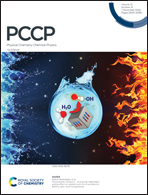Anharmonic coupling behind vibrational spectra of solvated ammonium: lighting up overtone states by Fermi resonance through tuning solvation environments†
Abstract
Studies on the vibrational spectra of various ammonium-centered clusters under different solvation environments have raised interest over the last thirty years. The gas-phase infrared photodissociation spectroscopy (IRPD) experiments showed that these NH4+⋯Xn clusters exhibit rich spectral features from 2600 to 3400 cm−1. In this work, we have simulated the vibrational spectra and analyzed couplings among vibrational quantum states in the aforementioned frequency range using ab initio anharmonic algorithms. Originating from the anharmonic couplings between NH stretching fundamentals and bending overtones, Fermi resonance (FR) is a common feature in these spectra, and its extent is determined by the magnitude of couplings and the energy matching conditions between relevant states, which are governed by the proton affinity, number, and bonding configuration of the solvation species. For weakly bound clusters consisting of rare gas atoms, FR is insignificant but not negligible; for strongly bound clusters, such as ammonium–water clusters, the hydrogen-bonded NH stretching fundamentals redshift and reach a better resonance condition, and thus light up the bending overtones as prominent FR bands. Our simulated spectra are in good agreement with previous experimental reports of these ammonium-centered clusters and provide a better understanding of the vibrational coupling behind the spectra of the NH stretching region.



 Please wait while we load your content...
Please wait while we load your content...